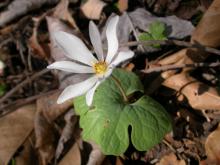Wildflowers, Grasses and Other Nonwoody Plants
Media

Species Types
Scientific Name
Phacelia purshii
Description
An annual, spring-blooming wildflower, Miami mist has loose coils of small blue flowers with distinctive, delicate fringes on the petal lobes.
Media

Species Types
Scientific Name
Hydrastis canadensis
Description
Large, crinkled, palmately 5-lobed leaves distinguish golden seal, which occurs in moist woods in the Ozarks and Central Missouri. Populations have been declining due to root diggers.
Media

Species Types
Scientific Name
Houstonia longifolia (sometimes Hedyotis longifolia)
Description
The petals of long-leaved bluets are not blue; they are white, often tinged with pink. Look for it in rocky, open Ozark woods, prairies, glades, and old fields in the southeastern half of the state. It prefers acid soils.
Media

Species Types
Scientific Name
Claytonia virginica
Description
Our most widely distributed early spring flower, spring beauty has 5 white or pink petals with distinct pink veining, and 5 pink anthers. The narrow, bladelike leaves are fleshy. These flowers often grow in abundance, covering a patch of ground with the beauty of spring.
Media

Species Types
Scientific Name
Sanguinaria canadensis
Description
Bloodroot’s pure white petals are even more remarkable given the plant’s bright red sap. This feature, plus the unique leaf shape, make this early spring wildflower easy to identify.
Media

Species Types
Scientific Name
Anemone canadensis
Description
White anemone is a showy native wildflower with interesting, deeply toothed leaves. Often occurring in colonies, it spreads easily (even aggressively) from rhizomes and is sometimes cultivated in wildflower gardens.
Media

Species Types
Scientific Name
Camassia scilloides
Description
In spring, wild hyacinth bears an elongated cluster of pale blue flowers with prominent anthers that sway on stalks up to 2 feet tall.
Media

Species Types
Scientific Name
Campanula americana
Description
Tall bellflower is an abundant native bellflower that is easily identified by its stout, tall habit, short, wheel-shaped, blue corolla, and the curved, purple style that projects beyond the flower.
Media

Species Types
Scientific Name
Ruellia strepens
Description
Although the funnel-shaped, 5-lobed flowers look something like the petunias you find at garden centers, our wild petunia is not related to them. This ruellia often has crinkled hairs in 2 narrow, lengthwise bands on opposite sides of the stalk.
Media

Species Types
Scientific Name
Podophyllum peltatum
Description
Mayapple is a common spring wildflower that makes its biggest impression with its leaves, which resemble umbrellas arising from a single stalk. It often grows in colonies.
See Also
About Wildflowers, Grasses and Other Nonwoody Plants in Missouri
A very simple way of thinking about the green world is to divide the vascular plants into two groups: woody and nonwoody (or herbaceous). But this is an artificial division; many plant families include some species that are woody and some that are not. The diversity of nonwoody vascular plants is staggering! Think of all the ferns, grasses, sedges, lilies, peas, sunflowers, nightshades, milkweeds, mustards, mints, and mallows — weeds and wildflowers — and many more!





















